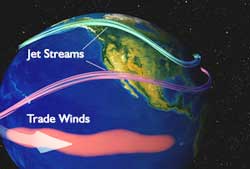NASA Satellites See El Nino Creep in From the Indian Ocean

The image shows what happens when a very strong El Nino strikes surface waters in the Central equatorial Pacific Ocean. The sequence shows warm water anomalies (red) develop in the Central Pacific Ocean. Winds that normally blow in a westerly direction weaken allowing the easterly winds to push the warm water up against the South American Coast. Credit: NASA
Scientists studied the winds and rains in the eastern Indian Ocean for hints at developing El Ninos. They used that information to create an “Index” or gauge that accurately predicted the El Nino of 2002-2003.
El Nino is signaled by a warming of the ocean surface off the western coast of South America that occurs every 4 to 12 years when cold, nutrient-rich water does not come up from the ocean bottom. It causes die-offs of plankton and fish and affects Pacific jet stream winds, altering storm tracks and creating unusual weather patterns in various parts of the world. The researchers used the TRMM and QuikScat satellites to track wind, rainfall, and warmer sea surface temperatures moving from the Indian to the Pacific Ocean in early 2002, before the 2002-03 El Nino.
During the winter of 2001-2002, climate conditions in the eastern Indian Ocean changed dramatically. Westerly winds increased and the weather flip-flopped from dry to wet.
Scott Curtis, Assistant Professor at East Carolina University, Greenville, N.C., and Robert Adler, George Huffman and Guojun Gu, all of NASA’s Goddard Space Flight Center, Greenbelt, Md. used NASA’s Tropical Rainfall Measuring Mission (TRMM) and QuikScat satellite data ranging from November 2001 to March 2002. “This study expands on recent work linking rain and wind changes over the last 25 years to the development of El Ninos,” Curtis said. The earlier study examined changes in rainfall from week to week, and the total amount of wintertime rainfall in key locations of the eastern Indian Ocean. They found these data points could be a sign of early shifts in climate leading to the development of El Ninos since 1979. The researchers then examined winds recreated by computer models, but did not find the same connections.
Curtis suggests that for the 1979-2002 period changes in rainfall in the eastern Indian Ocean are a better predictor for the onset of an El Nino than winds. Therefore, the El Nino Onset Index (EOI) was created using only rainfall data.
The scientists noticed the first weather system from the eastern Indian Ocean followed the Equator and the second traveled further south closer to Australia. In the second example, warm waters appeared first, followed by heavy rainfall in the eastern Indian Ocean. Then, strong westerly winds and a cooling of the sea surface developed. These events moved through the ocean area between Indonesia and Australia, suggesting a connection between rising air, wind, and sea surface temperatures over a period of days. These studies provided a basis for how changes in the East Indian Ocean are linked to following events in the Pacific Ocean, including the start of El Nino events.
There is a weak El Nino underway, according to the National Oceanic and Atmospheric Administration, which the EOI did not predict. Curtis explained that the EOI may not be sensitive enough to register weak episodes. In addition, the current El Nino is not basin-wide, as the far eastern Pacific Ocean is cooler than normal.
In the future, NASA will launch the Global Precipitation Measurement Mission which will contribute to the EOI, as TRMM does currently.
Media Contact
All latest news from the category: Earth Sciences
Earth Sciences (also referred to as Geosciences), which deals with basic issues surrounding our planet, plays a vital role in the area of energy and raw materials supply.
Earth Sciences comprises subjects such as geology, geography, geological informatics, paleontology, mineralogy, petrography, crystallography, geophysics, geodesy, glaciology, cartography, photogrammetry, meteorology and seismology, early-warning systems, earthquake research and polar research.
Newest articles

Parallel Paths: Understanding Malaria Resistance in Chimpanzees and Humans
The closest relatives of humans adapt genetically to habitats and infections Survival of the Fittest: Genetic Adaptations Uncovered in Chimpanzees Görlitz, 10.01.2025. Chimpanzees have genetic adaptations that help them survive…

You are What You Eat—Stanford Study Links Fiber to Anti-Cancer Gene Modulation
The Fiber Gap: A Growing Concern in American Diets Fiber is well known to be an important part of a healthy diet, yet less than 10% of Americans eat the minimum recommended…

Trust Your Gut—RNA-Protein Discovery for Better Immunity
HIRI researchers uncover control mechanisms of polysaccharide utilization in Bacteroides thetaiotaomicron. Researchers at the Helmholtz Institute for RNA-based Infection Research (HIRI) and the Julius-Maximilians-Universität (JMU) in Würzburg have identified a…



